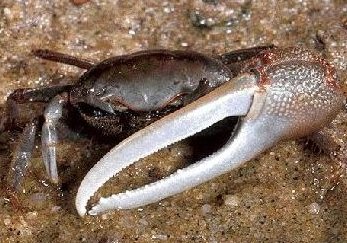|
| Query: Crab | Result: 1st of 1003 | |
Fiddler Crab (Family: Ocypodidae) - Wiki
| Subject: | Fiddler Crab (Family: Ocypodidae) - Wiki
| |

| Resolution: 347x243
File Size: 37097 Bytes
Upload Date: 2007:08:10 17:40:01
|
Fiddler crab
From Wikipedia, the free encyclopedia
[Photo] Fiddler crab (Uca pugnax) from NOAA CSC http://www.csc.noaa.gov/acebasin/specgal/inverts.htm
A fiddler crab, sometimes known as a calling crab, may be any of approximately 97 species of semi-terrestrial marine crabs within the genus Uca. Belonging to the family Ocypodidae, fiddler crabs are most closely related to the ghost crabs of the genus Ocypode.
Found in mangroves and on sandy or muddy beaches of West Africa, the Western Atlantic, Eastern Pacific and Indo-Pacific, fiddler crabs are easily recognized by their distinctively asymmetric claws. It is the males which boast an oversized claw or cheliped; it plays a role in courtship and signalling among conspecifics. The movement of the smaller claw from ground to mouth during feeding inspired the crabs' common name; it appears as if the animal is playing the larger claw like a fiddle.
Reaching a diameter of between 2 and 4½ cm (1???2 inches), fiddler crabs may be tan, blue-green, turquoise, black, yellow, or orange in colour. Diurnal animals, fiddler crabs are actually a darker colour by day than they are by night. They are an important source of food for shore birds and other animals inhabiting salt marshes. The crabs make burrows up to 60 cm (23 inches) deep in the muddy substrate to which they retreat during high tides. When the tide is out, fiddler crabs tirelessly scurry sideways along the beach as they comb the sands for food.
The crab's smaller claw picks up a chunk of sediment and brings it to the mouth, where its contents are sifted through. After anything edible is salvaged, be it algae, microbes, fungus, or other decaying detritus, the sediment is replaced in the form of a little ball. The presence of these sediment balls near the entrance to a burrow is a good indication of its occupation. Some experts believe that the feeding habits of fiddler crabs play a vital role in the preservation of wetland environments; by sifting through the sands, they aerate the substrate and prevent anaerobic conditions.
Fiddler crabs live rather brief lives of no more than two years (up to three years in captivity). During courtship, the males wave their oversized claws high in the air and tap them on the ground in an effort to attract females. Fights between other males will also occur, which are presumably meant to impress the females; if a male loses his larger claw, the smaller one will begin to grow larger and the lost claw will regenerate into a new (small) claw. For at least some species of fiddler crabs, however, the small claw remains small, while the larger claw regenerates over a period of several molts, being about half its former size after the first molt.
The female fiddler carries her eggs in a mass on the underside of her body. She remains in her burrow during a two week gestation period, after which she ventures out to release her eggs into the receding tide. The larvae remain planktonic for a further two weeks.
Fiddler crabs are occasionally kept as pets.
http://en.wikipedia.org/wiki/Fiddler_crab
| The text in this page is based on the copyrighted Wikipedia article shown in above URL. It is used under the GNU Free Documentation License. You may redistribute it, verbatim or modified, providing that you comply with the terms of the GFDL. |
|
Comments |
|---|
| | Guest |
|
| Uca pugnax, commonly known as the Atlantic marsh fiddler crab, is a species of fiddler crab that lives on north-eastern shores of the Atlantic Ocean. |
^o^
Animal Pictures Archive for smart phones
^o^
|
|
|